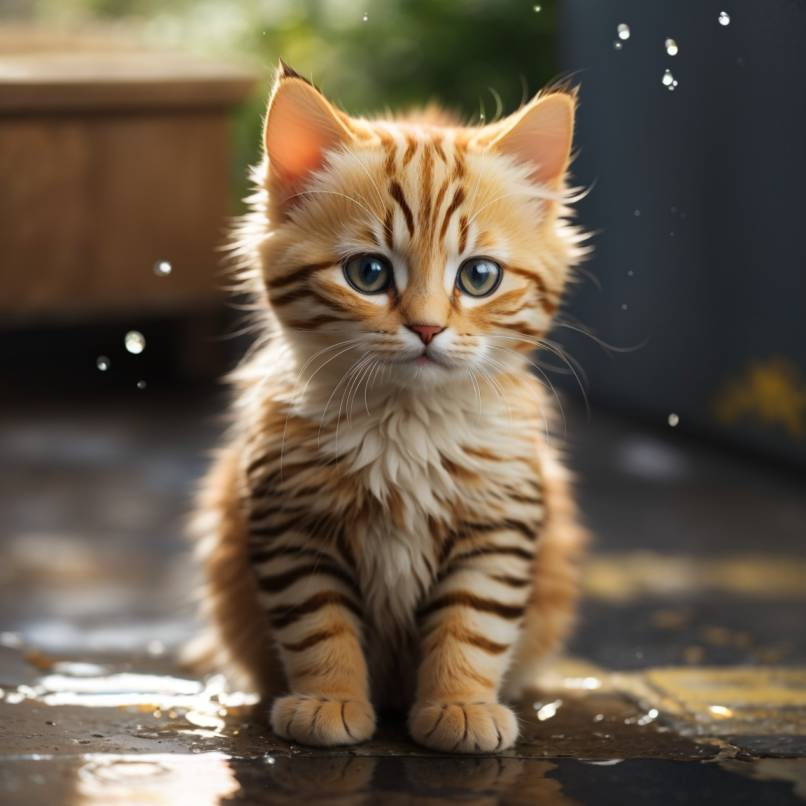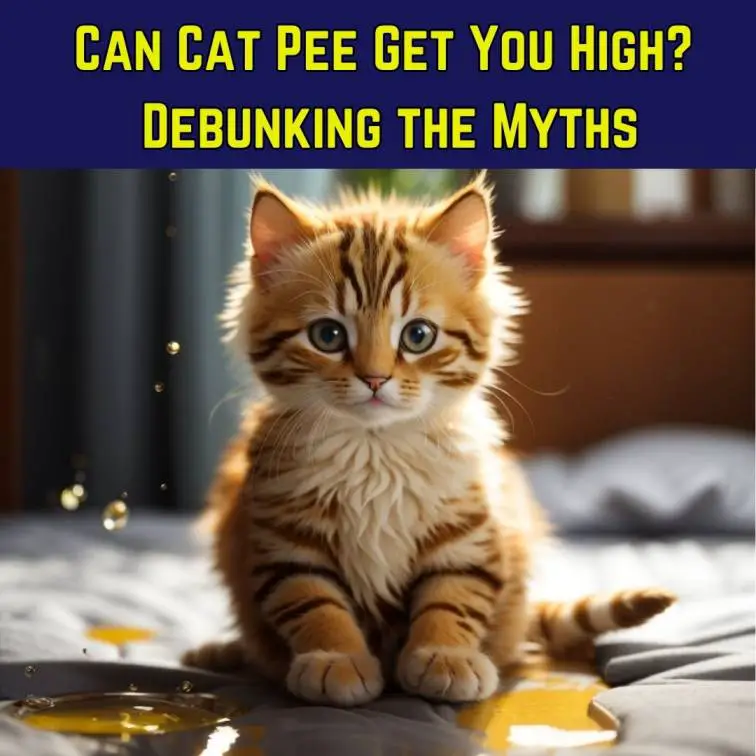Can Cat Pee Get You High? This unusual question has stirred curiosity and misinformation for years. In this blog post, we’ll address this intriguing myth head-on, uncovering the scientific realities behind it. But our journey doesn’t stop there. We’ll also explore the ethical dimensions of pet ownership, emphasizing the importance of treating our feline friends with care, compassion, and accurate knowledge. So, let’s embark on a quest to separate fact from fiction and advocate for responsible pet care together.
What is Cat Pee?

Before we dive into the myth, let’s clarify what “cat pee” actually means. Cat urine is the liquid waste product excreted by cats, primarily as a way to eliminate toxins from their bodies. It’s composed of water, urea, uric acid, creatinine, ammonia, and various other compounds. While cat urine can have a strong odor and may be unpleasant to deal with, it’s an essential part of a cat’s biology.
The High That Never Was
Now, let’s take a closer look at the myth that suggests you can get high from cat pee. This misconception has circulated for some time, but it’s important to clarify why it’s not rooted in reality.
Myth: You can get high from cat pee.
This myth might seem bizarre at first, but it’s worth examining how it came to be and why it’s biologically implausible.
The Origin of the Myth
The exact origin of this myth remains unclear, but it likely arises from several misunderstandings:
1. Ammonia Content: Cat urine does contain a compound called ammonia, which can release pungent fumes when it evaporates. Ammonia fumes can be irritating to the respiratory system, causing coughing or discomfort. Some people mistakenly associate this irritation with a “high.”
2. Urban Legends: Misconceptions about substances that can produce altered states of consciousness have fueled the myth. People often share sensational stories, and some might have invented tales about cat urine to shock or amuse others.
3. Lack of Knowledge: Many people lack accurate information about the chemical composition of cat urine. Without a clear understanding, they might be more susceptible to believing in the myth.
The Biological Reality
While ammonia can be an irritant, it’s important to emphasize that it doesn’t produce a psychoactive high like drugs or other substances. Here’s why:
1. Insufficient Concentration: Cat urine contains only trace amounts of ammonia. For it to induce any kind of psychoactive effect, the ammonia concentration would need to be much higher. Inhaling cat urine fumes would primarily result in discomfort, not a pleasurable high.
2. Biological Barriers: Our bodies have natural defenses against inhaling harmful substances. The respiratory system is designed to filter out irritants and protect the lungs. Inhaling cat urine fumes might cause coughing or discomfort, but it won’t lead to a high.
3. Health Risks: Attempting to get high from inhaling cat urine would pose serious health risks. Besides the discomfort, you could expose yourself to bacterial and viral contaminants present in the urine, potentially leading to infections or diseases.
Health Risks of Handling Cat Urine
While it’s clear that you can’t get high from cat urine, there are real health risks associated with handling this bodily waste. It’s crucial to understand and address these risks to ensure both your and your cat’s well-being.
1. Zoonotic Diseases
One significant health risk associated with cat urine is the potential transmission of zoonotic diseases. Zoonotic diseases are illnesses that can be passed from animals to humans. Some of the key zoonotic diseases that can be associated with cat urine include:
a. Toxoplasmosis
Toxoplasmosis is caused by a parasite called Toxoplasma gondii, which can be found in cat feces and urine. While it usually doesn’t cause serious symptoms in healthy individuals, it can be dangerous for pregnant women and those with weakened immune systems. Pregnant women who become infected with toxoplasmosis may pass the infection to their unborn child, potentially leading to birth defects.
b. Cat Scratch Fever
Cat scratch fever, also known as cat scratch disease, can be transmitted through a scratch or bite from an infected cat. Cat urine can carry the bacteria Bartonella henselae, which can cause this disease. Symptoms typically include fever, swollen lymph nodes, and overall discomfort.
c. Leptospirosis
Leptospirosis is a bacterial infection that can be transmitted through contact with water or soil contaminated with the urine of infected animals, including cats. Symptoms can range from mild flu-like symptoms to severe kidney and liver damage.
2. Allergies
Some individuals may be allergic to proteins present in cat urine. Exposure to cat urine can lead to allergic reactions, which can manifest in various ways, including:
- Skin rashes
- Itching
- Redness
- Hives
- Sneezing
- Runny or stuffy nose
- Coughing
- Wheezing
- Shortness of breath
If you suspect you have a cat urine allergy, it’s essential to consult with a healthcare professional for proper diagnosis and guidance on managing your allergy symptoms.
3. Respiratory Irritation
As mentioned earlier, cat urine contains ammonia, and inhaling ammonia fumes can irritate the respiratory system. While this irritation doesn’t lead to a high, it can cause discomfort and potential health issues, especially for individuals with pre-existing respiratory conditions like asthma.
4. Safe Handling and Disposal
Given these health risks, it’s crucial to practice safe handling and disposal of cat urine and litter. Here are some essential tips:
- Always wear gloves when cleaning litter boxes or handling cat urine.
- Wash your hands thoroughly with soap and water after any contact with cat waste.
- Keep litter boxes clean and scoop waste daily to reduce the potential for disease transmission.
- Dispose of used litter and waste in a sanitary and responsible manner, following local regulations and guidelines.
- Pregnant women and individuals with compromised immune systems should avoid cleaning litter boxes if possible. If they must do so, they should wear gloves and take extra precautions.
Urban Legends vs. Reality: Separating Fact from Fiction about Cats
In the world of pet myths and urban legends, cats have been the subject of countless sensational stories and misconceptions. It’s essential for responsible pet owners and enthusiasts to distinguish between these legends and the actual reality of cat behavior and biology. Let’s explore some common urban legends surrounding cats and the factual truths behind them.
1. Cats Steal Babies’ Breath
Urban Legend: This myth suggests that cats are drawn to the breath of infants and will smother them while they sleep, leading to the tragic “stealing” of a baby’s breath.
Reality: This legend is entirely untrue. Cats do not steal babies’ breath, nor do they pose any real danger to infants. Cats may be curious about new family members and might want to cuddle with a baby for warmth, but they do not cause harm intentionally. However, it’s still essential to supervise any interactions between cats and infants to ensure everyone’s safety.
2. Cats Always Land on Their Feet
Urban Legend: It’s widely believed that cats have a magical ability to always land on their feet, regardless of the height from which they fall.
Reality: While cats do have impressive agility and reflexes that often allow them to twist their bodies in mid-air to land on their feet, this doesn’t mean they’re immune to injury. Cats can still suffer severe injuries or even death from high falls. It’s a misconception to assume that cats are invincible when it comes to falls.
3. Cats Can See in Total Darkness
Urban Legend: Cats are said to have the ability to see perfectly in total darkness, as if they have night vision goggles.
Reality: While cats do have exceptional night vision, they cannot see in total darkness. They rely on minimal light to see effectively. Cats’ eyes have adapted to low-light conditions, thanks to specialized cells called rods, but complete darkness remains a challenge for them as it would for any other creature.
4. Cats Are Aloof and Unemotional
Urban Legend: Cats are often portrayed as aloof and unemotional animals that don’t form deep bonds with their human companions.
Reality: This is a widespread misconception. Cats can form strong attachments to their human caregivers and exhibit affection in various ways, such as purring, kneading, head-bunting, and even following their owners around. While cats may not display affection in the same way as dogs, they can be just as loving and loyal.
5. Cats Have Nine Lives
Urban Legend: The belief that cats have nine lives suggests that they are virtually indestructible and can survive numerous accidents and near-death experiences.
Reality: Cats do not have nine lives. This phrase is purely symbolic and comes from their remarkable ability to survive dangerous situations due to their agility and instincts. However, cats are still vulnerable to injuries, illnesses, and accidents, just like any other living creature.
Ethical Considerations in Pet Ownership: Dispelling Myths and Promoting Responsibility
When discussing the myth that suggests cat urine can get you high, it’s important to consider the broader ethical implications of perpetuating such myths. Ethical considerations in pet ownership extend beyond this particular myth to encompass how we treat animals and how we contribute to the dissemination of accurate information.
1. Treating Cats with Respect and Kindness

Responsible pet ownership begins with treating animals with the respect and kindness they deserve. Cats, like all animals, should be cared for in a manner that prioritizes their physical and emotional well-being. Believing that cats’ bodily waste can be used to achieve a “high” disrespects the natural dignity of these creatures.
2. The Consequences of Spreading Harmful Myths
Spreading myths, especially those that can lead to harm or mistreatment of animals, can have serious consequences. When people believe in myths about cats and their urine, they may approach these animals with fear or suspicion. This can lead to unwarranted mistreatment or neglect, harming the very pets we should care for.
5. Encouraging Critical Thinking
Encouraging critical thinking is another ethical consideration. Pet owners and enthusiasts should encourage people to question and verify information rather than blindly accepting myths and urban legends. This not only applies to cat-related myths but to all aspects of pet care and ownership.
FAQs (Frequently Asked Questions)
Q1: What can happen if you inhale cat pee?
Inhaling cat pee, especially in concentrated or enclosed spaces, can irritate your respiratory system. While it won’t get you high, it may cause coughing, discomfort, or allergic reactions. Additionally, cat urine can carry zoonotic diseases, so caution is necessary when dealing with it.
Q2: What is cheesing cats?
“Cheesing cats” is an internet meme and not a real practice. It involves briefly placing a slice of cheese on a cat’s back to capture their confused reaction. It’s crucial to treat animals with respect and not subject them to any potentially stressful or harmful situations for entertainment.
Q3: Why does my cat pee high?
Cats might pee high on walls or objects to mark their territory or communicate with other cats. It can also indicate a medical issue or discomfort. If this behavior is unusual, consult a veterinarian.
Q4: How potent is cat urine?
Cat urine’s potency varies depending on factors like the cat’s diet, hydration, and health. While it can be pungent, it is not potent enough to produce any psychoactive effects.
Q5: How toxic is cat litter?
Cat litter is generally safe when used as intended. However, some types of clumping litter can pose risks if ingested by cats. Always choose cat litter that’s labeled as safe for your cat’s use.
Q6: Can cat urine set off a smoke detector?
No, cat urine cannot set off a smoke detector. Smoke detectors are designed to detect smoke particles or rising temperatures, not urine odors.
Q7: Is cat huffing safe?
No, cat huffing is not safe and should never be attempted. Inhaling any substances, including cat urine or its fumes, can be harmful and pose health risks.
Q8: What is smoked cat?
“Smoked cat” is not a real concept. It’s likely a misunderstanding or misinformation. Cats should never be exposed to smoke or harmful substances.
Q9: Why did my cat pee on me?
Cats may urinate on their owners for various reasons, such as marking territory, stress, or medical issues. Consult with a veterinarian to address the underlying cause.
Q10: Why does my cat pee on my bed right in front of me?
Peeing on your bed could be a sign of a medical issue or behavioral problem. It may also be a cry for attention or due to stress. Consult with a vet to rule out medical causes and consider behavioral training or changes.
Conclusion-
In conclusion, the notion that cat pee can get you high is nothing more than a baseless myth. While cat urine can pose health risks if mishandled, it’s essential to separate fact from fiction. Promoting responsible pet ownership and dispelling harmful rumors are essential steps towards creating a more informed and compassionate community of pet lovers. So, the next time you hear this peculiar myth, you can confidently debunk it with the facts. Remember, cats deserve our care and respect, not unfounded rumors.

